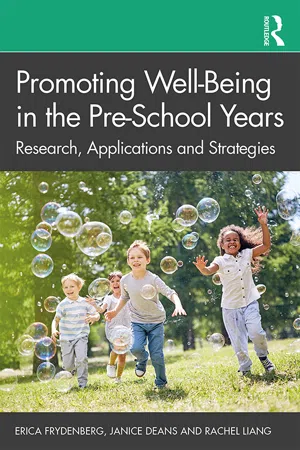
Promoting Well-Being in the Pre-School Years
Research, Applications and Strategies
- 178 pages
- English
- ePUB (mobile friendly)
- Available on iOS & Android
Promoting Well-Being in the Pre-School Years
Research, Applications and Strategies
About This Book
Promoting Well-Being in the Pre-School Years provides evidence-based research and real-life strategies that support social and emotional development and well-being for children aged 3–5 years. It places emphasis on nurturing social emotional competence through purposeful scaffolding activities and how these can be used by children and families to create a harmonious platform for building resilience and positive relationships with family and the community.
Drawing on principles from Positive Psychology and Positive Education, it is illustrated throughout with examples of sustainable practice in diverse, global settings. Key topics explored include:
- Contemporary well-being concepts, including 'grit', 'growth mindset' and 'gratitude', as well as 'classic' constructs such as coping and self-efficacy
- The attitudes and skills that need to be developed to ensure that young children flourish
- Cognitive and sociocultural perspectives complemented by neuroscience and epigenetics
- Social Emotional Learning (SEL) in the early years curriculum
- Using visual tools – the Early Years Coping Cards
- How we measure young children's coping
- The relationship between coping, stress and mental health
- Recognition of the importance of parents' own coping skills
- How partnerships with communities can improve children's SEL.
Promoting Well-Being in the Pre-School Years shows how we can support young children to develop an understanding of what it means to be happy and to flourish as a socially responsible member of the family and wider community. It is essential reading for teachers, parents and professionals who work with young children, as well as academics in child development.
Frequently asked questions
Information
Chapter 1
Capturing the well-being construct in the pre-school years
Overview
Health and well-being
The global context
National agenda on children’s well-being
- physical health and well-being
- social competence
- emotional maturity
- language and cognitive skills (school-based)
- communication skills and general knowledge.
Positive Psychology, Positive Education, well-being and coping
Well-being as flourishing

Positive Education in the pre-school years
Different concepts and constructs in Positive Psych...
Table of contents
- Cover
- Half Title
- Title Page
- Copyright Page
- Table of Contents
- List of figures
- List of tables
- Foreword
- Preface
- Acknowledgements
- 1. Capturing the well-being construct in the pre-school years
- 2. Development in context
- 3. Social Emotional Learning (SEL) in the early years curriculum
- 4. Early years visual coping tools: operationalising social and emotional competencies in pre-school children
- 5. Measuring coping in a pre-school population
- 6. The relationship between coping, stress and mental health in a pre-school population
- 7. Teaching coping skills in the context of positive parenting
- 8. Approaches to pre-school Social Emotional Learning: targeting empathy, resilience, prosocial and problem behaviour through coping strategies
- 9. Embedding SEL within the curriculum: partnerships with communities
- 10. Putting it together: developing well-being in the early years
- Index